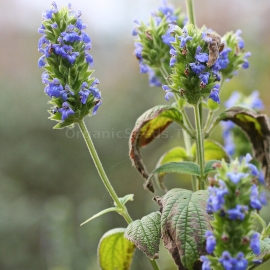



«Espaniola» - Organic Chia Black seeds
1.14 €
An annual plant up to 1 m high, opposite leaves 4-8 cm long and 3-5 cm wide, blue or purple flowers, is a natural source of antioxidants, including chlorogenic acid, caffeic acid, myricetin, quercetin and flavonols.
-
Chia black or Spanish sage (lat.Salvia hispanica)
Plant of the Lamiaceae family, a species of the genus Sage. Chia seeds are traditionally eaten by people in some countries in Latin America (especially Mexico), as well as in the southwestern United States. The closely related species Salvia columbariae (fr) is also used in cooking.
The homeland of Spanish sage is Central and Southern Mexico, as well as Guatemala, where it grows at an altitude of 1800-2600 m above sea level. Nowadays it is also cultivated in many countries of South America and Australia.
Annual herb up to 1 m high. Leaves are opposite 4-8 cm long and 3-5 cm wide. The flowers are blue or purple. Seeds are small, oval, usually about 1 mm in diameter. They are brown, gray, black or blue, speckled on the surface with a relief pattern.
Spanish sage seeds are of two types: blue and black. There is no difference between them, except for color.
Spanish sage is a great natural source of antioxidants, including chlorogenic acid, caffeic acid, myricetin, quercetin, and flavonols.
Chia seeds also contain essential omega-3 fatty acids, alpha-linolenic and linoleic acids, mucin, strontium, 30% protein, vitamins A, B, E, and D, and minerals including calcium, phosphorus, potassium, sulfur, iron, iodine, copper, zinc, sodium, magnesium, manganese, niacin, thiamine, silicon.
A tablespoon of chia seeds contains:
2 times more calcium than in a glass of milk,
3 times more Omega-3 than 50 grams of salmon,
1.5 times more antioxidants than 100 grams of blueberries,
2 times more potassium than one banana,
3 times more iron than 100 grams of spinach.
Roasted seed flour is used to make nutritious drinks. The lard from them, mixed with water and pepper, lasts a long time, is highly nutritious and satisfies hunger well. The seed oil dries quickly and is used to make paints.
Recently, Spanish sage seeds have gained popularity among US vegetarians as an excellent source of plant calcium: 100 grams of seeds contain 631 mg of calcium, i.e. twice as much as in a glass of milk. The seeds are also rich in other trace elements. In 2005, the European Union, where the plant is much less known, recognized chia as a promising food.
Currently, Spanish sage seeds are being studied as a potential natural treatment for type 2 diabetes because they have the ability to slow the rise in sugar and cholesterol levels.
Chia seeds develop a gelatinous coating when exposed to liquids. If you try to put a spoonful of chia in a glass of water and leave for 10 minutes, when you return, you will see a gelatinous mixture. This gelling reaction occurs due to the accumulation of natural fibers in the chia, which aid in water absorption.
The chia mixture entering the stomach forms a physical barrier between carbohydrates and digestive enzymes, which slows down the conversion of carbohydrates into sugar.
In addition to the obvious benefits for diabetics, this slowdown in the conversion of carbohydrates to sugar provides an opportunity to build endurance. Carbohydrates are the fuel for energy in our bodies. Prolongation of their conversion to sugar stabilizes metabolic changes, reducing the bursts of highs and lows that create a longer duration in the body's resources.
The Mendoza Codex indicates that Spanish sage was the most important crop of the Aztecs. Jesuit chroniclers claimed that this plant occupied the third place in their diet after corn and beans, ahead of amaranth.
